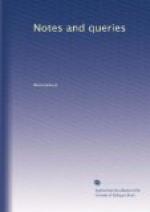The Yakuti (and Tungusi?) call it “schaar.” The Crim Tartars call it “tuetuen.” The Koreans give it the name of the province of Japan whence they first received it. In the Tartar (Calmuc and Bashkir?) “gansa” is a tobacco-pipe. In America itself tobacco has many names, viz. “goia,” “gozobba” or “cohobba,” “petun,” “y’ouly,” “yoly,” and “uppwoc.” Are there any proofs of its growing wild in America? At the discovery it was every where found in a state of cultivation. The only mention I have met with is in Drake’s Book of the Indians[3], where he says it grew spontaneously at Wingandacoa[4], and was called by the natives “uppewoc.” Does not this very notice imply something unusual? and might not this have been a deserted plantation?
The Indians have always looked to Europeans for presents of tobacco, which they economise by mixing with willow-bark, the uva-ursi, &c., and there are some tribes totally unacquainted with its use. M’Kenzie says, the Chepewyans learnt smoking from Europeans, and that the Slave and Dogrib Indians did not even know the use of tobacco.
In mentioning the silence of early visitors to the East on the subject of smoking, I might have added equally the silence of the Norwegian visitors to America on the same subject.
A.C.M.
Exeter, July 25. 1850.
[Footnote 2: There is no positive notice of its introduction into Turkey, Persia, or Russia?]
[Footnote 3: Book iv., p. 5., ed. 8vo., Boston.]
[Footnote 4: Virginia.]
The tobacco-plant does not appear to be indigenous to any part of Asia. Sir John Chardin, who was in Persia about the year 1670, relates in his travels, that tobacco had been cultivated there from time immemorial. “Honest John Bell” (of Antermony), who travelled in China about 1720, asserts that it is reported the Chinese have had the use of tobacco for many ages. Rumphius, who resided at Amboyna towards the end of the seventeenth century, found it universal over the East Indies, even in countries where Spaniards or Portuguese had never been. The evidence furnished by these authors, although merely traditional, is the strongest which I am aware of in favour of an Asiatic origin for the use of tobacco.
Mr. Lane, on the other hand, speaks of the “introduction of tobacco into the East, in the beginning of the seventeenth century of our era,” (Arabian Nights, Note 22. cap. iii.), “a fact that has been completely established by the researches of Dr. Meyer of Konigsberg, who discovered in the works of an old Hindostanee physician a passage in which tobacco is distinctly stated to have been introduced into India by the Frank nations in the year 1609.” (Vide An Essay on Tobacco, by H.W. Cleland, M.D. 4to. Glasgow, 1840, to which I am indebted for the information embodied in this reply to Z.A.Z., and to which I would beg to refer him for much curious matter on the subject of tobacco.)




